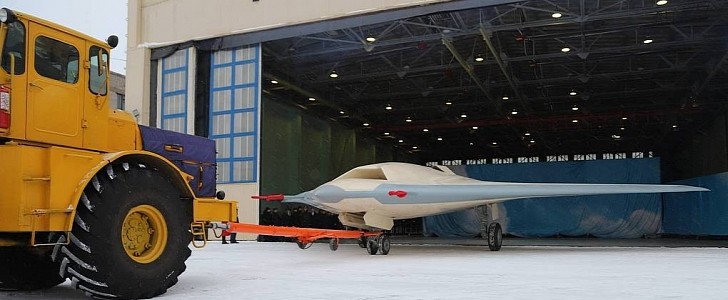After much anticipation, the sixth-generation heavy attack drone for the Russian Army was unveiled by the United Aircraft Corporation of the Rostec military-economic institution. Designed as a fierce “loyal wingman” for the Su-57 next-generation fighter jet, the Hunter is ready to take Russia’s combat capabilities to the highest level.
Russian military officials are gearing up for the first flight of the new Hunter heavy strike drone, recently unveiled at the Novosibirsk Aviation Enterprise. Officially named the Sukhoi S-70 Okhotnik-B, this unmanned combat aerial vehicle (UCAV) is an upgraded version of the first Hunter drone, which conducted its debut flight in 2019. At the time, the Okhotnik flew for 30 minutes, together with the Su-57, operating in automated mode, at an altitude of over 5,200 feet (1,600 meters).
The main advantage of the latest version is that it’s even stealthier, thanks to the new thruster with a flat nozzle that reduces its radar signature, in addition to its special silhouette without a tail. The innovative 3D-printed flat nozzle makes this drone harder to detect by enemy missiles. Also, designed to operate together with the Su-57, the drone is capable of striking both air and ground targets.
According to the Russian media, a pilot of the next-generation fighter jet would be able to coordinate up to four Okhotnik drones at the same time. So, each Su-57 could operate with not just one but a group of deadly drones. These stealthy aerial vehicles also have a take-off weight of 22 tons and can fly at over 620 mph (1,000 kph). The Su-57 (and its export version, the Su-57E) itself was also designed with a high level of automation and a low radar signature, in addition to sustaining supersonic flight even in challenging conditions. Together with the new heavy strike drone, it’s bound to become even deadlier.
The next step after the unveiling of the first flight prototype of the Hunter is to prepare for flight tests. The Russian troops are expected to start receiving the state-of-the-art Okhotnik drones by 2024.
The main advantage of the latest version is that it’s even stealthier, thanks to the new thruster with a flat nozzle that reduces its radar signature, in addition to its special silhouette without a tail. The innovative 3D-printed flat nozzle makes this drone harder to detect by enemy missiles. Also, designed to operate together with the Su-57, the drone is capable of striking both air and ground targets.
According to the Russian media, a pilot of the next-generation fighter jet would be able to coordinate up to four Okhotnik drones at the same time. So, each Su-57 could operate with not just one but a group of deadly drones. These stealthy aerial vehicles also have a take-off weight of 22 tons and can fly at over 620 mph (1,000 kph). The Su-57 (and its export version, the Su-57E) itself was also designed with a high level of automation and a low radar signature, in addition to sustaining supersonic flight even in challenging conditions. Together with the new heavy strike drone, it’s bound to become even deadlier.
The next step after the unveiling of the first flight prototype of the Hunter is to prepare for flight tests. The Russian troops are expected to start receiving the state-of-the-art Okhotnik drones by 2024.






